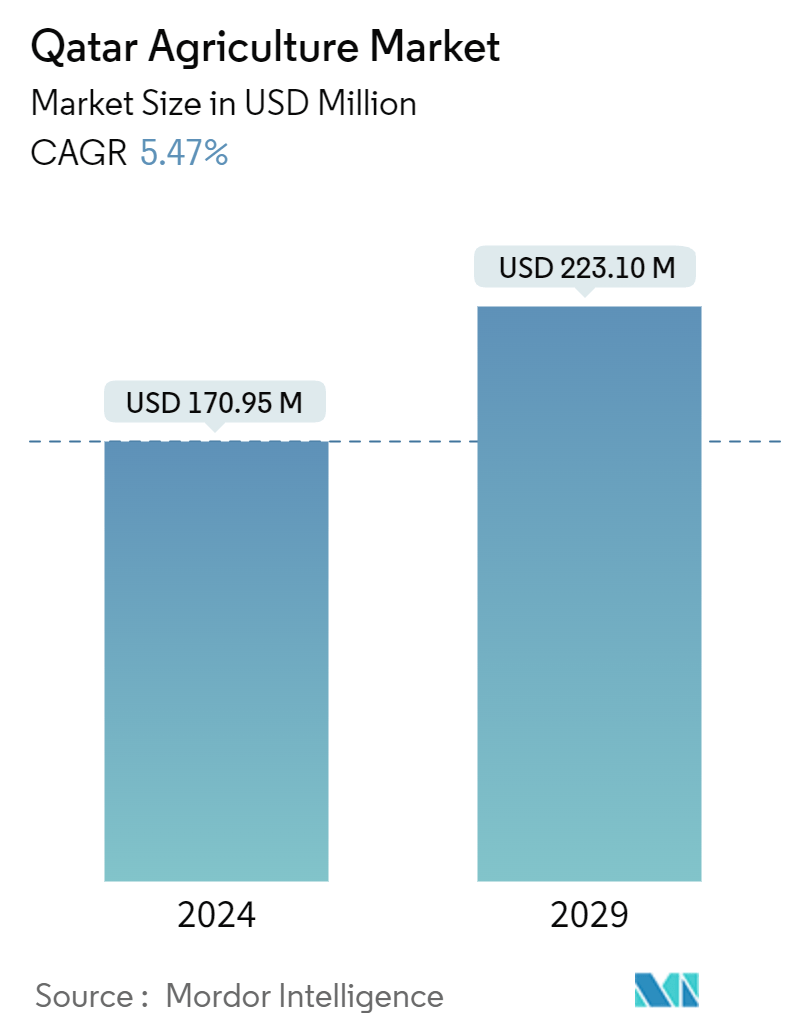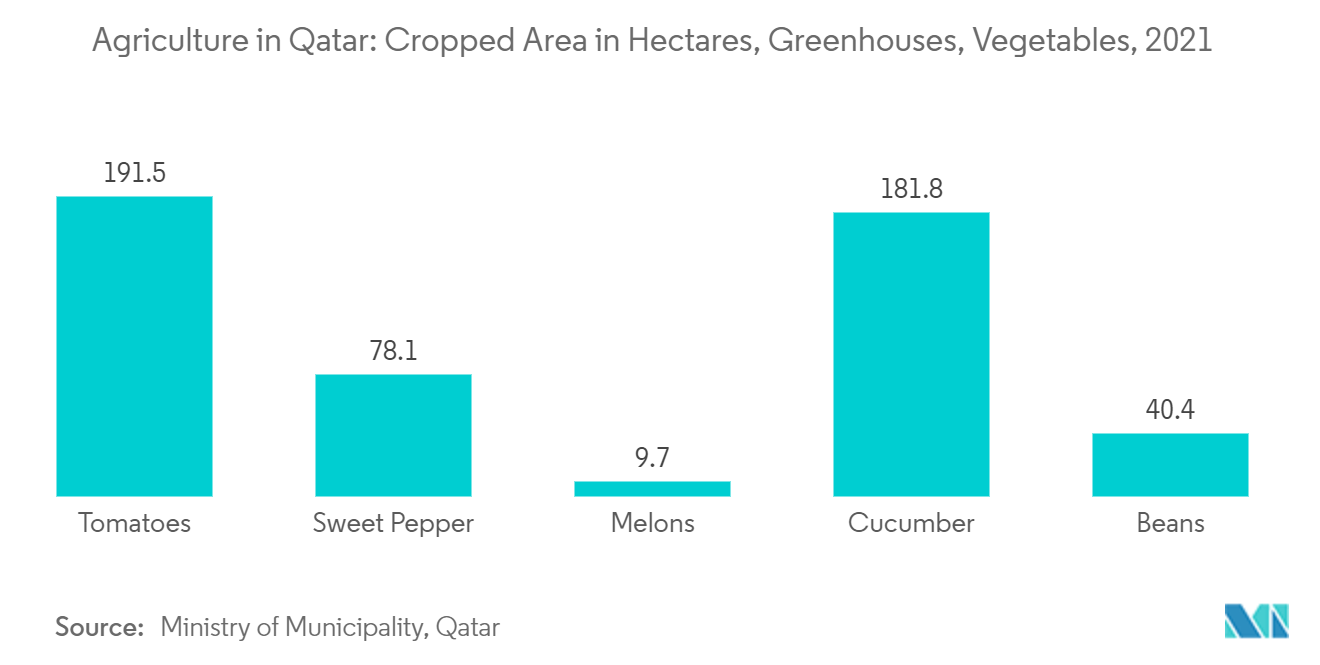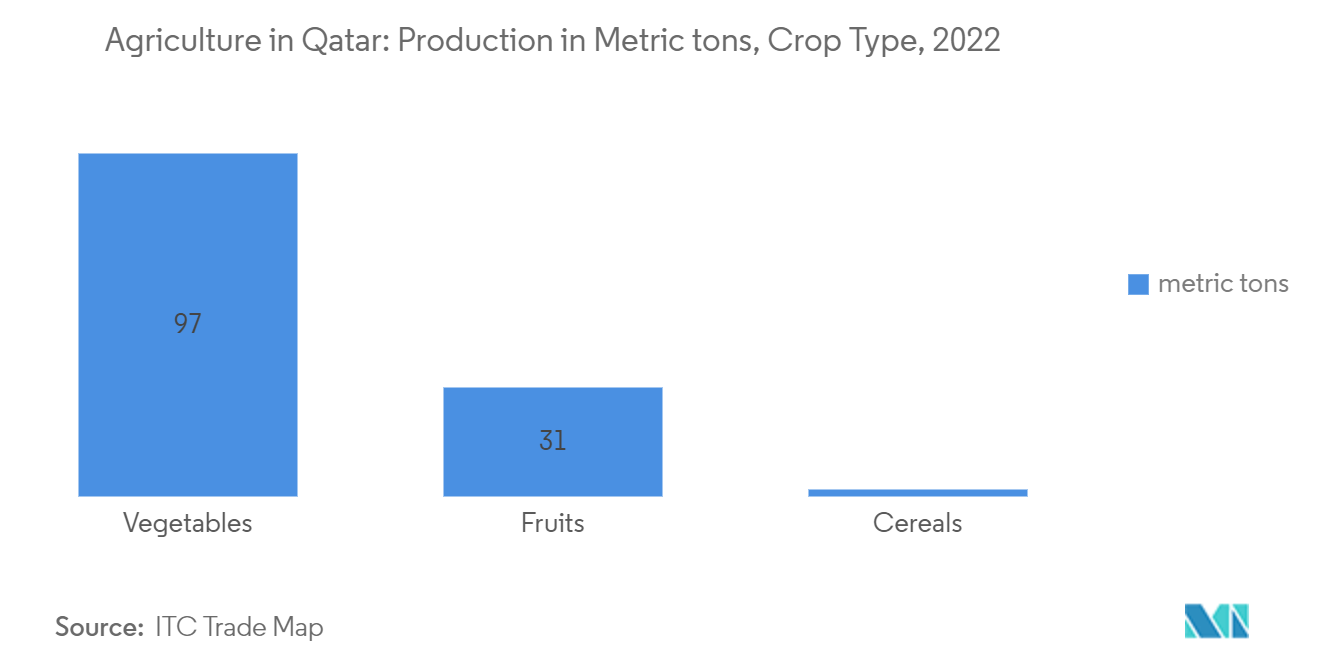Qatar Agriculture Market Size

| Study Period | 2019 - 2029 |
| Base Year For Estimation | 2023 |
| Forecast Data Period | 2024 - 2029 |
| Market Size (2024) | USD 170.95 Million |
| Market Size (2029) | USD 223.10 Million |
| CAGR (2024 - 2029) | 5.47 % |
Major Players*Disclaimer: Major Players sorted in no particular order |
Qatar Agriculture Market Analysis
The Qatar Agriculture Market size is estimated at USD 170.95 million in 2024, and is expected to reach USD 223.10 million by 2029, growing at a CAGR of 5.47% during the forecast period (2024-2029).
The Qatari agricultural industry has seen significant growth in recent years, driven by rising food demand due to rapid population expansion and government-led efforts to bolster food security. These initiatives have ushered in notable advancements, including the enactment of the Public Private Partnership (PPP) law, the streamlining of distribution channels, and financial incentives to boost domestic production. Notably, despite Qatar's arid climate, the nation has embraced sustainable practices, leveraging technologies like automated irrigation, aquaponics, and hydroponics to elevate the yield and quality of its agricultural produce.
Despite substantial capital investments in bolstering domestic agricultural production, Qatar heavily depends on imports to satisfy its escalating consumption demands. Imported products include cereals, fruits, and vegetables. Major exporters like Brazil, the United States, India, and Australia cater to this need. According to the ITC Trade Map, Qatar imported vegetables worth USD 0.26 million in 2022, which was 13% higher compared to the previous year. Similarly, the country imported cereals worth USD 0.26 million in 2022, which was 35% more in comparison to the previous year.
Qatar Agriculture Market Trends
Rising Adoption of Sustainable and Smart Technologies Boosting Agriculture in Qatar
Qatar, known for its low rainfall and high temperatures, has tackled these hurdles head-on. In recent years, the nation has embraced innovative agricultural methods, including hydroponics, smart irrigation, and aquaponics. These approaches not only enhance the use of arable land but also elevate the quality of its produce. One of the country’s standout innovations is aquaponics, a method that merges aquaculture and hydroponics. In 2021, Qatar launched its national agriculture project, which was developed through an aquaponic system that utilizes aquaculture and hydroponics.
Furthermore, the Department at the Ministry of Municipality is working to encourage farms by launching various agricultural initiatives and providing technical support and services to farmers. The government has completed 58% of the drive to distribute and install greenhouses. In 2022, the country produced the highest vegetable production of tomatoes, with 44,923.6 metric tons, with coverage of an area of 666 hectares in greenhouses, followed by cucumber and sweet pepper. Such developments will drive the country to adopt smart farming practices to become self-sufficient in agricultural production over the coming years.
Qatar University's Agricultural Research Station (ARS) has developed a cutting-edge vertical farming system to address the country’s agricultural challenges. This innovative method involves growing plants indoors in stacked layers, optimizing space and resource use. The system utilizes precise climate control, LED lights, and automation for year-round, high-quality production. The ARS is further adapting this technology to Qatar's specific conditions, promising new research opportunities and a sustainable local food source. For instance, in 2021, iFarm joined forces with Sadarah to enhance sustainable vertical farming in Qatar. They jointly manage a large-scale indoor farm, utilizing iFarm's advanced technology that recycles unused water.

The Vegetable Segment Dominates the Market
According to the Minister of Municipality and Environment, Qatar is planning to achieve self-sufficiency in vegetable production over the coming years. The country started its new Qatar National Food Security Strategy 2024-30 by leveraging the achievements accomplished by the 2018-23 National Food Security Strategy. This new strategy will enable a more sustainable food security system for the country in terms of increasing self-sufficiency in vegetables like tomatoes, cucumbers, peppers, cauliflower, potatoes, eggplant, onions, and cabbage. For instance, in 2022, the country's vegetable production reached 97,519 metric tons, representing a significant 71% share of the nation's total agricultural output, underscoring its market dominance.
Local farms in Qatar are enhancing their vegetable production through advanced methods that are tailored for both outdoor and indoor cultivation. These efforts encompass the adoption of cutting-edge equipment and techniques specifically designed for the nation's hot and arid climate. From greenhouses to water-conserving irrigation methods and innovative cooling technologies, these advancements ensure a year-round supply of vegetables, bolstering Qatar's domestic production. Consequently, these initiatives are fueling the growth of the local vegetable market, with many agricultural farms in the country scaling up their production. For instance, Executive Director of Business Relations at Hassad Food Mubarak Al Sahouti said that the quantity of vegetables received from domestic farms increased by 20% in 2023 in comparison to the previous year. The domestic market requirement is 2,000 metric tons of cucumbers and 6,000 metric tons of tomatoes, which are procured from Qatari farms during the agriculture season.

Qatar Agriculture Market News
- January 2024: The Ministry of Municipality (MoM) in Qatar initiated a project focusing on 'protected farms' and climate-smart agriculture. The objective is to transform open farm areas into enclosed spaces, thereby curbing evaporation, minimizing water loss, and addressing soil challenges.
- March 2023: QSTP's (Qatar Science & Technology Park) pioneering VFarms Lab unveiled an experimental farm that operates without external water sources by using a solar-powered atmospheric water generator. This innovative technology extracts water directly from the air, making a significant stride toward sustainable and self-sufficient agriculture in Qatar.
Qatar Agriculture Market Report - Table of Contents
1. INTRODUCTION
- 1.1 Study Assumptions and Market Definition
- 1.2 Scope of the Study
2. RESEARCH METHODOLOGY
3. EXECUTIVE SUMMARY
4. MARKET DYNAMICS
- 4.1 Market Overview
-
4.2 Market Drivers
- 4.2.1 Increasing Food Demand by Growing Population Fueling Market Growth
- 4.2.2 Rising Adoption of Sustainable and Smart Technologies Boosting Agriculture
- 4.2.3 Government Initiatives for Self-sufficiency Driving The Market
-
4.3 Market Restraints
- 4.3.1 Unfavorable Climatic Conditions Limiting Production
- 4.3.2 Reliance on Agriculture Imports
5. MARKET SEGMENTATION (Production Analysis by Volume, Consumption Analysis by Value and Volume, Import Analysis by Value and Volume, Export Analysis by Value and Volume, and Price Trend Analysis)
- 5.1 Food Crops/Cereals
- 5.2 Fruits
- 5.3 Vegetables
6. Regional Analysis
- 6.1 PESTLE Analysis
- 6.2 Supply Chain Analysis
- 6.3 Government Policies
7. MARKET OPPORTUNITIES AND FUTURE TRENDS
** Subject To AvailablityQatar Agriculture Industry Segmentation
Agriculture is the art and science of the cultivation of crops. For the study, all the major crops grown in the country using open fields and protected cultivation are also considered. The scope includes only fresh produce. The Qatari agriculture market is segmented by food crops/cereals, fruits, and vegetables. The report includes the production analysis by volume, consumption analysis by value and volume, export analysis by value and volume, import analysis by value and volume, and wholesale price trend analysis. The report offers market sizing in terms of both value (USD) and volume (metric tons).
Qatar Agriculture Market Research FAQs
How big is the Qatar Agriculture Market?
The Qatar Agriculture Market size is expected to reach USD 170.95 million in 2024 and grow at a CAGR of 5.47% to reach USD 223.10 million by 2029.
What is the current Qatar Agriculture Market size?
In 2024, the Qatar Agriculture Market size is expected to reach USD 170.95 million.
What years does this Qatar Agriculture Market cover, and what was the market size in 2023?
In 2023, the Qatar Agriculture Market size was estimated at USD 161.60 million. The report covers the Qatar Agriculture Market historical market size for years: 2019, 2020, 2021, 2022 and 2023. The report also forecasts the Qatar Agriculture Market size for years: 2024, 2025, 2026, 2027, 2028 and 2029.
Qatar Agriculture Industry Report
Statistics for the 2024 Qatar Agriculture market share, size and revenue growth rate, created by Mordor Intelligence™ Industry Reports. Qatar Agriculture analysis includes a market forecast outlook to 2029 and historical overview. Get a sample of this industry analysis as a free report PDF download.



